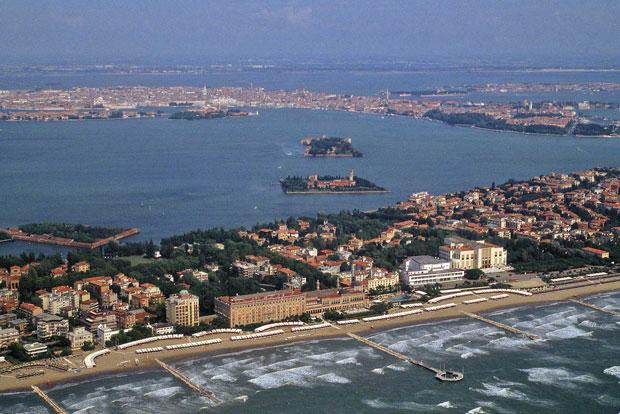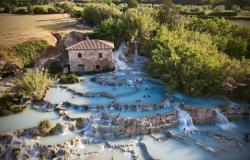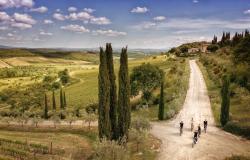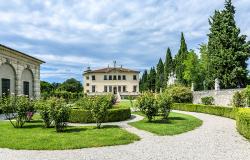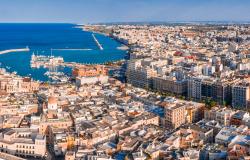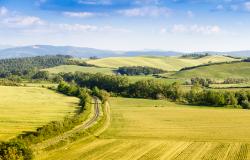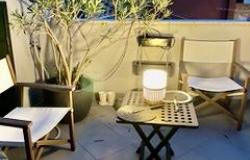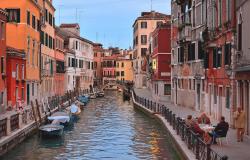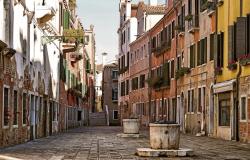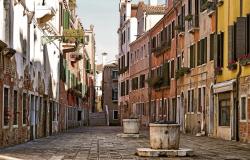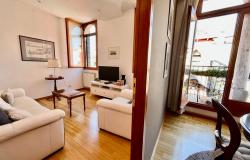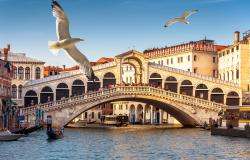Only the lagoon divides it from Venice; yet the Lido is as distant from the noise and confusion of the Venice tourist crowds as it could be. Except for around 10 days every year between the end of August and the beginning of September, when celebrities - and with them scores of fans – flock to the Lido for the Venice International Film Festival, held at the Palazzo del Cinema. Founded in 1932 by the president of the Biennale di Venezia, the count Giuseppe Volpi di Misurata, the festival has attracted the big stars of cinema, such as Greta Garbo and Clark Gable, since its beginnings.
The rest of the year, the slow pace of life at the Lido, a thin stretch of land extending in front of Venice for 11 km, can be appreciated on a day tour biking its minor streets, with the Venice Lagoon on one side and the Adriatic Sea on the other. A leisurely biking pace gives visitors the chance to appreciate the light, the colors, the water reflections, the saltish water smell, while admiring historic and artistic remnants.
The main mooring place for the Lido is Piazzale Santa Maria Elisabetta, where it is possible to rent the bikes. Begin on Lungomare Guglielmo Marconi, the liveliest area with the Palazzo della Mostra del Cinema, the Venice Casino, and the luxury Grand Hotel et des Bains and Grand Hotel Excelsior (the red carpet for the Venice Film Fest goes right from the Excelsior to the Palazzo del Cinema and on the hotel’s terrace gather the fans who wait to get a glimpse of their idols arriving by water taxi).  Lungomare Marconi is where you will find the beaches that gave birth to the seaside tourism phenomenon. It became a cosmopolitan seaside resort between the 18th and 19th century. There are no umbrellas and chairs like you would find at many other Italian beaches; here, they use the famous “capanne”, such as the elegant white tents of the Excelsior. In the past, this area was frequented by the likes of Lord Byron, who could be seen horse-riding or swimming across the lagoon, and Thomas Mann, who took inspiration for his 1912 “Death in Venice” novel from his stays at the Hotel Des Bains. The splendor of times past is testified by the numerous liberty-style villas owned by rich Venetians who came here for their seaside vacations. Part of the itinerary takes place on the “murazzi”, which begin at the end of the Lungomare Marconi; they are an important architectural endeavor built by the Venice Republic in the 18th century to defend the island from sea storms.
Lungomare Marconi is where you will find the beaches that gave birth to the seaside tourism phenomenon. It became a cosmopolitan seaside resort between the 18th and 19th century. There are no umbrellas and chairs like you would find at many other Italian beaches; here, they use the famous “capanne”, such as the elegant white tents of the Excelsior. In the past, this area was frequented by the likes of Lord Byron, who could be seen horse-riding or swimming across the lagoon, and Thomas Mann, who took inspiration for his 1912 “Death in Venice” novel from his stays at the Hotel Des Bains. The splendor of times past is testified by the numerous liberty-style villas owned by rich Venetians who came here for their seaside vacations. Part of the itinerary takes place on the “murazzi”, which begin at the end of the Lungomare Marconi; they are an important architectural endeavor built by the Venice Republic in the 18th century to defend the island from sea storms.  Proceeding south, you will encounter Malamocco, the first and, for a long time, only settlement of the Lido. Dating back to Roman times, when it was called Metamaucum, it was the Episcopal seat in the 7th century and capital of the Duchy of Venice between the 8th and 9th centuries; today it is a tranquil, colorful fishermen’s village gathered around the church of Santa Maria Assunta (13th century) and the gothic Palazzo del Podestà (15th century). After Malamocco, on the south tip of the island, is Alberoni, one of the oldest seaside resorts of the Lido. Just behind the shore is the Oasi delle Dune, a WWF protected area with tall sand dunes and a wild natural habitat.
Proceeding south, you will encounter Malamocco, the first and, for a long time, only settlement of the Lido. Dating back to Roman times, when it was called Metamaucum, it was the Episcopal seat in the 7th century and capital of the Duchy of Venice between the 8th and 9th centuries; today it is a tranquil, colorful fishermen’s village gathered around the church of Santa Maria Assunta (13th century) and the gothic Palazzo del Podestà (15th century). After Malamocco, on the south tip of the island, is Alberoni, one of the oldest seaside resorts of the Lido. Just behind the shore is the Oasi delle Dune, a WWF protected area with tall sand dunes and a wild natural habitat.  From here you can cacth the ferry to Pellestrina, a timeless, tiny sandbar, where, in some points, you can walk from one side to the other in just a few steps. Some of the small fishermen’s villages, with their colorful houses, little squares, calli and seafood smells include Santa Maria del Mare, San Pietro in Volta and Pellestrina, the most populated of the three; it is divided into four neighborhoods (sestieri) that take the name from the families that were sent here by the Magistrate of Chioggia in the 14th century: Busetto, Vianello, Zennaro and Scarpa. Pellestrina marks the end of the tour. It is another 20 km to head back to Piazzale Santa Maria Elisabetta on the Lido. Take your time, stop at one of the local restaurants for a grigliata di pesce and absorb the tranquility before immersing yourself back into Venice’s crowds.
From here you can cacth the ferry to Pellestrina, a timeless, tiny sandbar, where, in some points, you can walk from one side to the other in just a few steps. Some of the small fishermen’s villages, with their colorful houses, little squares, calli and seafood smells include Santa Maria del Mare, San Pietro in Volta and Pellestrina, the most populated of the three; it is divided into four neighborhoods (sestieri) that take the name from the families that were sent here by the Magistrate of Chioggia in the 14th century: Busetto, Vianello, Zennaro and Scarpa. Pellestrina marks the end of the tour. It is another 20 km to head back to Piazzale Santa Maria Elisabetta on the Lido. Take your time, stop at one of the local restaurants for a grigliata di pesce and absorb the tranquility before immersing yourself back into Venice’s crowds. 
